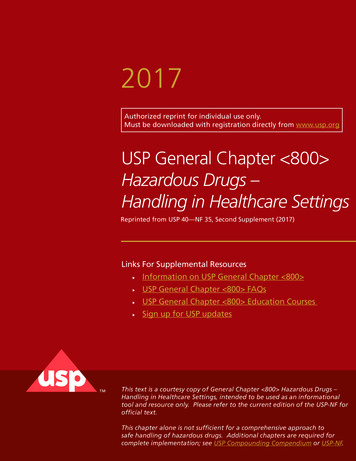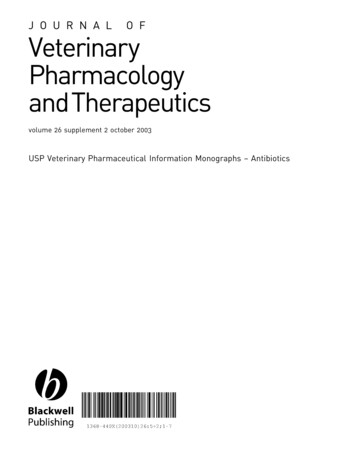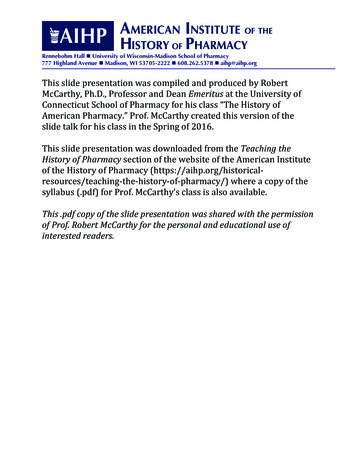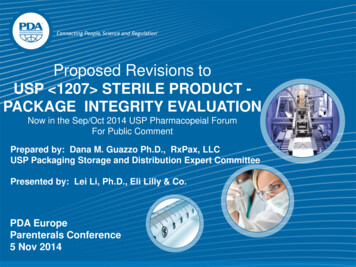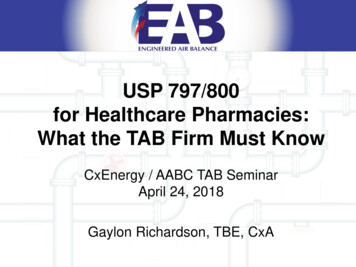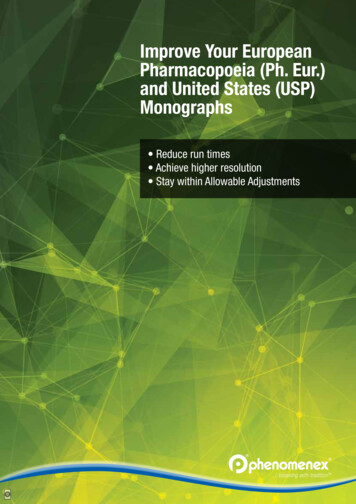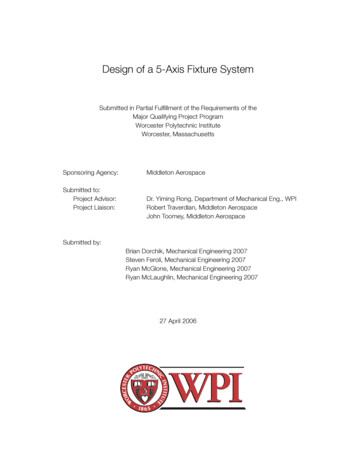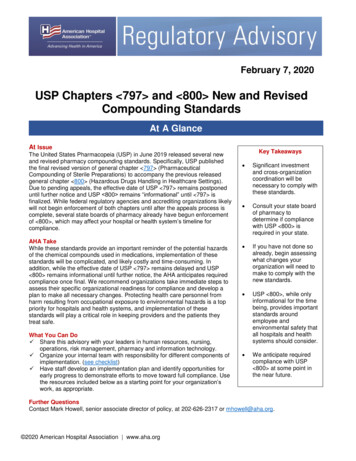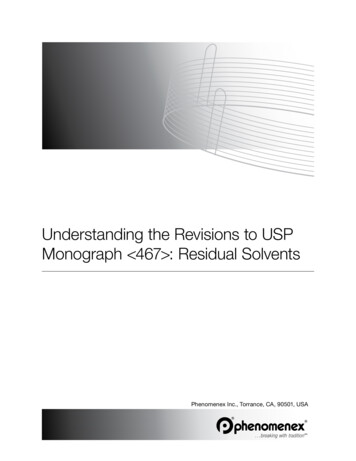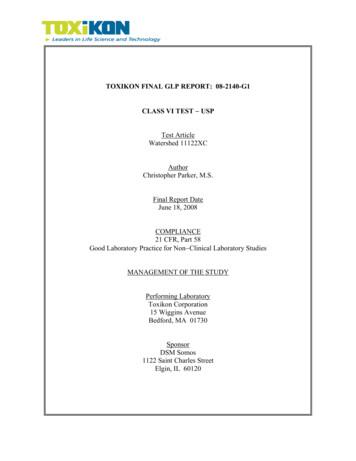
Transcription
TOXIKON FINAL GLP REPORT: 08-2140-G1CLASS VI TEST USPTest ArticleWatershed 11122XCAuthorChristopher Parker, M.S.Final Report DateJune 18, 2008COMPLIANCE21 CFR, Part 58Good Laboratory Practice for Non Clinical Laboratory StudiesMANAGEMENT OF THE STUDYPerforming LaboratoryToxikon Corporation15 Wiggins AvenueBedford, MA 01730SponsorDSM Somos1122 Saint Charles StreetElgin, IL 60120
Class VI Test USPProject Number: 08-2140-G1Test Article: Watershed 11122XCTABLE OF CONTENTSTitle PageTable of ContentsStudy SummaryQuality Assurance StatementStudy Director Signature and Verification fication of Test and Control Articles5.0Identification of Test System6.0Justification of Test System and Route of Administration7.0Experimental Design and Dosage8.0Evaluation fidentiality Agreement13.0Animal Welfare StatementTable 1:Table 2:Table 3:Table 4:Systemic Injection Test: Animal Weights and Clinical ObservationsIntracutaneous Injection and Implant Tests: Animal Weights and ClinicalObservationsIntracutaneous Test Skin Reaction ScoresImplant Test: Macroscopic ObservationsAppendix I:Evaluation of Skin ReactionsPage 2 of 21
Class VI Test USPProject Number: 08-2140-G1Test Article: Watershed 11122XCSTUDY SUMMARYThe USP 0.9% Sodium Chloride for Injection (NaCl), Cottonseed Oil (CSO), 1 in 20 Ethanol inNaCl (EtOH), and Polyethylene Glycol 400 (PEG) extracts of the test article and the test article,Watershed 11122XC, did not produce a biological response following intramuscularimplantation in rabbits, intracutaneous injection in rabbits, or systemic injection in mice.Therefore, the test article meets the requirements of the USP guidelines, for Class VIPlastics 50 C.Page 3 of 21
Class VI Test USPProject Number: 08-2140-G1Test Article: Watershed 11122XC1.0 PURPOSEThe purpose of the study was to determine the biological response of animals to direct andindirect contact with the test article or injection of the test article extract.2.0 REFERENCESThe study was conducted based upon the following references:2.1United States Pharmacopeia 31, National Formulary 26, 2008. 88 BiologicalReactivity Tests, In Vivo.2.2ISO/IEC 17025, 2005, General Requirements for the Competence of Testing andCalibration Laboratories.3.0 COMPLIANCEThe study conformed to the current FDA 21 CFR, Part 58 Good Laboratory Practice forNon Clinical Laboratory Studies.4.0 IDENTIFICATION OF TEST AND CONTROL ARTICLESThe Sponsor supplied the following information on a test requisition form or othercorrespondence, wherever applicable (excluding confidential or trade secret information). TheSponsor was responsible for all test article characterization data as specified in the GLPregulations.4.1 Test Article:Test Article Name: Watershed 11122XCCAS/Code #: Not Supplied by Sponsor (N/S)Lot/Batch #: 1300249Physical State: N/SColor: N/SExpiration Date: N/SDensity: N/SStability: N/SSolubility: N/SpH: N/SStorage Conditions: Room TemperatureSafety Precautions: Standard Toxikon Laboratory Safety Precautions4.2 Control Articles (Toxikon Supplied):4.2.1 Negative Control Article Name: USP 0.9% Sodium Chloride for Injection (NaCl)Toxikon QC #: CSC-08-03-010-VVPhysical State: LiquidPage 6 of 21
Class VI Test USPProject Number: 08-2140-G1Test Article: Watershed 11122XCColor: ColorlessStability: Stable at Room TemperatureStorage Conditions: Room TemperatureSafety Precautions: Standard Laboratory Safety Precautions4.2.2 Negative Control Article Name: Cottonseed Oil (CSO)Toxikon QC #: CSC-08-05-009-VVPhysical State: LiquidColor: YellowStability: Stable at Room TemperatureStorage Conditions: Room TemperatureSafety Precautions: Standard Laboratory Safety Precautions4.2.3 Negative Control Article Name: 1 in 20 Ethanol in NaCl (EtOH)Toxikon QC #: CSC-06-11-007-VV; CSC-08-03-010-VVPhysical State: LiquidColor: ColorlessStability: Stable at Room TemperatureStorage Conditions: Room TemperatureSafety Precautions: Standard Laboratory Safety Precautions4.2.4 Negative Control Article Name: Polyethylene Glycol 400 (PEG)Toxikon QC #: CSC-06-09-012-VVPhysical State: LiquidColor: ColorlessStability: Stable at Room TemperatureStorage Conditions: Room TemperatureSafety Precautions: Standard Laboratory Safety Precautions4.2.5 Negative Control Article Name: Negative Control High Density Polyethylene(Negative Control Plastic)Toxikon QC #: CSC-04-05-009-CCPhysical State: SolidColor: WhiteStorage Conditions: Room TemperatureSafety Precautions: Standard Laboratory Safety Precautions5.0 IDENTIFICATION OF TEST SYSTEM5.1 Animals Used in the Study:5.1.1 Systemic Injection Test:Number and Species: 40 Albino Swiss Mice (Mus musculus)Sex: female (females were non pregnant and nulliparous)Page 7 of 21
Class VI Test USPProject Number: 08-2140-G1Test Article: Watershed 11122XCWeight/Age Range: 17.1 22.9 grams / at least 34 days old (adult)weighed to the nearest 0.1 gHealth Status: healthy, not previously used in other experimental proceduresAnimal Purchase: Harlan, Indianapolis, INAnimal Identification: ear punchAcclimation: minimum 3 days, under same conditions as for the actual testAnimal Selection: selected from larger pool and examined to ensure lack of adverseclinical signs5.1.2 Intracutaneous Injection and Implant Tests:Number and Species: 6 New Zealand White rabbits (Oryctolagus cuniculus)Sex: 3 males and 3 females (females were non pregnant and nulliparous)Weight/Age Range: 2.36 2.70 kilograms for Intracutaneous2.78 3.09 kilograms for Implant Testat least 10 weeks old (young adult)weighed to nearest 10 gHealth Status: healthy, Intracutaneous animals not previously used in other experimentalprocedures and Implant animals previously used in other experimentalproceduresAnimal Purchase: Millbrook Breeding Labs, Amherst, MAAnimal Identification: ear markerAcclimation: minimum 3 days, under same conditions as for the actual testAnimal Selection: selected from larger pool and examined to ensure lack of adverseclinical signs5.2 Animal Care and Maintenance:5.2.1 Systemic Injection Test:Animal Room Temperature: 68 5 FAnimal Room Relative Humidity: 30 70%Air Exchanges per Hour: a minimum of 10 changes per hourLights: 12 hour light/dark cycle, full spectrum fluorescent lightsHousing: group housed (5 per cage of same sex)Cages: polycarbonatePage 8 of 21
Class VI Test USPProject Number: 08-2140-G1Test Article: Watershed 11122XCBedding: hardwood chips, P.W.I. Industries, St Hyacinthe, Quebec, Canada (contact)Animal Rations: TEK 7012 Rodent Diet, Harlan Teklad, Madison, WI, ad libitumWater: tap water, ad libitumThere were no known contaminants present in the feed, water, or bedding expected tointerfere with the test data.The laboratory and animal rooms were maintained as limited access facilities.5.2.2 Intracutaneous Injection and Implant Tests:Animal Room Temperature: 68 5 FAnimal Room Relative Humidity: 30 70%Air Exchanges per Hour: a minimum of 10 changes per hourLights: 12 hour light/dark cycle, full spectrum fluorescent lightsHousing: individually housedCages: suspended stainless steelBedding: hardwood chips, P.W.I. Industries, St Hyacinthe, Quebec, Canada(non contact)Animal Rations: TEK Hi Fiber Rabbit Diet 2031, Harlan Teklad, Madison, WI,ad libitumWater: tap water, ad libitumThere were no known contaminants present in the feed, water, or bedding expected tointerfere with the test data.The laboratory and animal rooms were maintained as limited access facilities.6.0 JUSTIFICATION OF TEST SYSTEM AND ROUTE OF ADMINISTRATION6.1 Albino mice and rabbits were used in this study because they have historically been used inUSP Class VI tests and the guidelines have no alternative (non animal) methods. The speciesand number of animals used in this study were recommended by the USP guidelines.6.2 Systemic injection in mice, intracutaneous injection, and intramuscular implantation inrabbits are recommended by the USP guidelines for Class VI tests.6.3 The test article was exposed to the test system directly and through solvents compatible withthe test system.Page 9 of 21
Class VI Test USPProject Number: 08-2140-G1Test Article: Watershed 11122XC7.0 EXPERIMENTAL DESIGN AND DOSAGE7.1 Preparation of Test and Control Articles:7.1.1 Systemic and Intracutaneous Testing Preparation:7.1.1.1 The test article (60 cm2) was combined with 10 mL of vehicle at a ratio of120 cm2 per 20 mL per USP guidelines. The test article was separately extracted inNaCl, CSO, EtOH, and PEG at 50 2 C for 72 2 hours.7.1.1.2 Properly prepared test articles were placed in separate extraction bottles, and toeach bottle the appropriate medium was added. The extraction medium completelycovered the test article.7.1.1.3 Each extracting medium (control article) was prepared for parallel treatments andcomparisons. Each control article was prepared in the same manner as the test article.7.1.1.4 The Systemic Injection and Intracutaneous tests were performed using the sameextracts. The test article appeared unchanged by the extraction procedure. It was notdegraded or deformed. The extract was clear and free from particulates. Each extractwas agitated vigorously prior to administration. All other test article preparation was asspecified by the Sponsor.7.1.2 Implant Testing Preparation:The test and control articles were cut into strips measuring 1 mm 10 mm. The test andcontrol article strips were sterilized by dipping in 70% ethanol prior to implantation.7.2 Pre Dose Procedure:7.2.1 Systemic Injection Test:7.2.1.1 Acclimated animals were weighed prior to dosing.7.2.1.2 For the Systemic Injection Test, the PEG test article extract and thecorresponding control were diluted with NaCl to obtain PEG concentration ofapproximately 200 mg/mL.7.2.2 Intracutaneous Injection Test:7.2.2.1 On the day of the test, the animals were weighed and clipped free of fur on thedorsal side.7.2.2.2 For the Intracutaneous Test, the PEG test article extract and the correspondingcontrol were diluted with NaCl to obtain PEG concentration of approximately120 mg/mL.Page 10 of 21
Class VI Test USPProject Number: 08-2140-G1Test Article: Watershed 11122XC7.2.3 Implant Test:Two rabbits were used for the Implantation Test. On the day of the test, the animals wereweighed and the skin on both sides of the spinal column was clipped free of fur. Each animalwas anesthetized to prevent muscular movement.7.3 Dose Administration:7.3.1 Systemic Injection Test:Groups of 5 animals were injected with either the test article extract or the correspondingcontrol article extract in the same amounts and by the same routes set forth ritonealIntravenousIntraperitonealDose/kg50 mL50 mL50 mL10 gInjection Rate0.1 mL/second 0.1 mL/second 7.3.2 Intracutaneous Injection Test:7.3.2.1 A volume of 0.2 mL of each test article extract was injected intracutaneously atfive sites on one side of each of two rabbits. More than one test article extract was usedper rabbit.7.3.2.2 At five sites on the other side of each rabbit, 0.2 mL of the corresponding controlarticle was injected.7.3.3 Implant Test:Four samples of the test article were implanted into the paravertebral muscle on one side ofthe spine of each of two rabbits (2.5 to 5.0 cm from the midline, parallel to the spinal columnand about 2.5 cm from each other). In a similar fashion, two strips of the Negative ControlPlastic were implanted in the contralateral muscle of each animal.7.4 Post Dose Procedure:7.4.1 Systemic Injection Test:7.4.1.1 The animals were observed for clinical signs immediately after injection, 4 hoursafter injection, and at 24, 48, and 72 2 hours after injection. Observations conductedincluded all clinical and toxicologic signs.7.4.1.2 The animals were weighed at the end of the observation period.7.4.1.3 Animals were sacrificed by carbon dioxide inhalation.Page 11 of 21
Class VI Test USPProject Number: 08-2140-G1Test Article: Watershed 11122XC7.4.2 Intracutaneous Injection Test:7.4.2.1 The injection sites on each animal were observed for signs of erythema andedema 24, 48, and 72 hours after injection of the test article. Observations were scoredaccording to the Evaluation of Skin Reactions (Appendix I). Observations conductedalso included all clinical signs.7.4.2.2 All average erythema and edema scores for the test and control sites at 24, 48,and 72 hours were totaled separately and divided by 12 (2 animals 3 scoring periods 2 scoring categories) to determine the overall mean score for the test article versus thecorresponding control article.7.4.2.3 Animals were weighed at the end of the observation period.7.4.2.4 The animals were returned to the general colony.7.4.3 Implant Test:7.4.3.1 The animals were maintained for a period of 7 days.7.4.3.2 The animals were observed daily for this period to ensure proper healing of theimplant sites and for clinical signs of toxicity. Observations included all clinicalmanifestations.7.4.3.3 At the end of the observation period, the animals were weighed. Each animalwas sacrificed by an injectable barbiturate.7.4.3.4 Sufficient time was allowed to elapse for the tissue to be cut without bleeding.7.4.3.5 The area of the tissue surrounding the center portion of each implant strip wasexamined macroscopically using a magnifying lens. Hemorrhaging, necrosis,discolorations, and infections were scored using the following scale:0 Normal1 Mild2 Moderate3 SevereEncapsulation, if present, was scored by first measuring the width of the capsule (thedistance from the periphery of the implant to the periphery of the capsule) rounded to thenearest 0.1 mm. The encapsulation was scored as follows:Capsule WidthScoreNoneUp to 0.5 mm0.6 to 1.0 mm1.1 to 2.0 mmGreater than 2.0 mm01234Page 12 of 21
Class VI Test USPProject Number: 08-2140-G1Test Article: Watershed 11122XCThe differences between the average scores for the test article and control article implantsites were calculated.8.0 EVALUATION CRITERIA8.1 Systemic Injection Test:The test is considered negative if none of the animals injected with the test article show asignificantly greater biological reaction than the animals treated with the control article.If two or more mice die, or show signs of toxicity such as convulsions or prostration, or if threeor more mice lose more than 2 g of body weight, the test article does not meet the requirementsof the test. If any animal treated with a test article shows only slight signs of biological reaction,and not more than one animal shows gross signs of biological reaction or dies, a repeat test isconducted using groups of 10 mice. On the repeat test, all 10 animals must not show asignificantly greater biological reaction than the animals treated with the control article.8.2 Intracutaneous Injection Test:The requirements of the test are met if the difference between the test article and control articlemean reaction scores (erythema/edema) is 1.0 or less.If at any observation point, the average reaction to the test article sites is questionably greaterthan the corresponding control article sites, a repeat for the particular test article extract/solutionis conducted using an additional 3 rabbits. On the repeat test, the requirements of the test is metif the difference between the test article and control article mean reaction scores(erythema/edema) is 1.0 or less.8.3 Implant Test:The test is considered negative if, in each rabbit, the difference between the average scores foreach category of biological reaction for the test article and control article implant sites does notexceed 1.0; or if the difference between the mean scores for all categories of biological reactionfor each test article and the average score for all categories for all the control implant sites doesnot exceed 1.0, for not more than one of four test article strips.8.4 Class VI Requirements:The test article satisfies the requirements of the USP Class VI test if the requirements describedabove are met.8.5 The study and its design employ methodology to minimize uncertainty of measurement andcontrol of bias for data collection and analysis.9.0 RESULTS9.1 Systemic Injection Test:9.1.1 Animal Weights:All of the test and control animals increased in weight (Table 1).Page 13 of 21
Class VI Test USPProject Number: 08-2140-G1Test Article: Watershed 11122XC9.1.2 Clinical Observations:None of the test or control animals exhibited overt signs of toxicity at any of the observationpoints (Table 1).9.1.3 The test is considered negative because none of the animals injected with extracts ofthe test article showed a significantly greater biological reaction than the animals treated withthe control articles.9.2 Intracutaneous Injection Test:9.2.1 Animal Weights:All of the animals increased in weight (Table 2).9.2.2 Clinical Observations:There were no overt signs of toxicity observed in any test or control animals (Table 2).9.2.3 The difference between the test article and control article mean reaction scores(erythema/edema) was less than 1.0. The test article meets the requirements of theIntracutaneous Test (Table 3).9.3 Implant Test:9.3.1 Animal Weights:Both animals increased in weight (Table 2).9.3.2 Clinical Observations:There were no overt signs of toxicity noted in either animal. Macroscopic evaluation of thetest and control article implant sites showed no significant infection, encapsulation,hemorrhage, necrosis, or discoloration (Tables 2 and 4).9.3.3 The test is considered negative, since in each rabbit the difference between the averagescores for all of the categories of biological reaction for the test article and control articleimplant sites did not exceed 1.0, and the difference between the mean scores for allcategories of biological reaction for all of the test article implant sites and the average scorefor all categories for all the control implant sites did not exceed 1.0. The test article meetsthe requirements of the Implantation Test (Table 4).10.0 CONCLUSIONThe USP 0.9% Sodium Chloride for Injection (NaCl), Cottonseed Oil (CSO), 1 in 20 Ethanol inNaCl (EtOH), and Polyethylene Glycol 400 (PEG) extracts of the test article and the test article,Watershed 11122XC, did not produce a biological response following intramuscularimplantation in rabbits, intracutaneous injection in rabbits, or systemic injection in mice.Therefore, the test article meets the requirements of the USP guidelines, for Class VIPlastics 50 C.Page 14 of 21
Class VI Test USPProject Number: 08-2140-G1Test Article: Watershed 11122XC11.0 RECORDS11.1Original raw data are archived at Toxikon Corporation.11.2A copy of the final report and any report amendments is archived at ToxikonCorporation.11.3The original final report, and a copy of any protocol amendments or deviations, isforwarded to the Sponsor.11.4All used and unused test article shall be disposed of by Toxikon, per Sponsor’s request.12.0 CONFIDENTIALITY AGREEMENTStatements of confidentiality were not agreed upon prior to study initiation.13.0 ANIMAL WELFARE STATEMENTThe Sponsor assured that, to the best of their knowledge, this study did not unnecessarilyduplicate previous testing and that there were no non animal alternatives acceptable for theevaluation of this test article as defined by the protocol.No evidence of pain and suffering was reported to the Veterinarian and/or Study Director.Toxikon strictly adhered to the following standards in maintaining the animal care and useprogram:United States Department of Agriculture (USDA), Animal and Plant Health Inspection Service,9 CFR Ch. 1 (1/1/95 edition), Subchapter A Animal Welfare.“Guide for the Care and Use of Laboratory Animals,” National Research Council, 1996. (NIH).Office for Laboratory Animal Welfare (OLAW), “Public Health Service Policy on Humane Careand Use of Laboratory Animals,” Health Research Extension Act of 1985 (Public Law 99 158November 20, 1985), Reprinted 1996.ISO 10993 2, 2006, Biological Evaluation of Medical Devices Part 2: Animal WelfareRequirements.Association for the Assessment and Accreditation of Laboratory Animal Care (AAALAC)International.Page 15 of 21
Class VI Test USPProject Number: 08-2140-G1Test Article: Watershed 11122XCTABLE 1Systemic Injection Test:Animal Weights and Clinical ObservationsTest Article: Watershed 11122XCLot/Batch #: 1300249Body Weight (g)GroupAnimal #SexDose (mL)Day 0Day 2Female1.019.021.42.4NaCl Test3Female1.122.725.22.550 male1.020.522.01.57Female1.121.122.51.4NaCl Control8Female1.019.421.72.350 Female1.122.825.22.412Female1.121.123.52.4CSO Test13Female1.121.523.31.850 6Female1.019.121.22.117Female1.122.925.62.7CSO Control18Female0.918.320.72.450 1Female0.917.119.82.722Female0.917.319.01.7EtOH Test23Female1.019.322.02.750 6Female1.020.923.32.427Female1.122.824.61.8EtOH Control28Female1.121.323.82.550 1Female1.019.722.32.632Female0.917.119.62.5PEG Test33Female1.019.521.62.110 Female1.020.322.62.337Female1.020.822.61.8PEG Control38Female1.122.224.82.610 g/kg39Female0.917.419.31.940Female1.020.221.61.4* Summary of clinical observations - Immediately, 4, 24, 48, and 72 h after injection.Page 16 of 21Signs eNoneNoneNoneNoneNone
Class VI Test USPProject Number: 08-2140-G1Test Article: Watershed 11122XCTABLE 2Intracutaneous Injection and Implant Tests:Animal Weights and Clinical ObservationsTest Article:Watershed 11122XCLot/Batch #:1300249Body Weight (kg)GroupSigns ofToxicity*Animal #SexDay 005/27/08Day 80927Male2.702.870.17NoneAnimal #SexDay 005/27/08Day 8Female3.093.340.25NoneNaCl & CSOEtOH & PEGBody Weight (kg)GroupSigns ofToxicity*Implant* Summary of Clinical Observations, Day 0 through Day 3, excluding skin reactionsfor the Intracutaneous Injection Test and Day 0 through Day 7 for the Implant Test.Page 17 of 21
Class VI Test USPProject Number: 08-2140-G1Test Article: Watershed 11122XCTABLE 3Intracutaneous Test Skin Reaction ScoresTest Article: Watershed 11122XCLot/Batch #: 1300249NaCl ExtractAnimal #Vehicle80904NaCl80905NaClTime24 hours48 hours72 hours24 hours48 hours72 hoursT 10/00/00/00/00/00/0T 20/00/00/00/00/00/0T 30/00/00/00/00/00/00.0T 40/00/00/00/00/00/0Site NumbersScoring (ER/ED)T 5 C 1 C /00/0TotalOverall Mean Score for Test Article 0.0Overall Mean Score for Control Article 0.0Difference between Test Article and Control Article Overall Mean Score 0.0 0.0 0.0C 30/00/00/00/00/00/00.0C 40/00/00/00/00/00/0C 50/00/00/00/00/00/0C 30/00/00/00/00/00/00.0C 40/00/00/00/00/00/0C 50/00/00/00/00/00/0CSO ExtractAnimal #Vehicle80904CSO80905CSOTime24 hours48 hours72 hours24 hours48 hours72 hoursT 10/00/00/00/00/00/0T 20/00/00/00/00/00/0T 30/00/00/00/00/00/00.0T 40/00/00/00/00/00/0Site NumbersScoring (ER/ED)T 5 C 1 C /00/0TotalOverall Mean Score for Test Article 0.0Overall Mean Score for Control Article 0.0Difference between Test Article and Control Article Overall Mean Score 0.0 0.0 0.0ER Erythema; ED Edema; T Test Sites; C Control Sites Overall Mean Score Total erythema plus edema scores divided by 12(2 animals 3 scoring periods 2 scoring categories)Page 18 of 21
Class VI Test USPProject Number: 08-2140-G1Test Article: Watershed 11122XCTABLE 3Intracutaneous Test Skin Reaction Scores (Cont.)Test Article: Watershed 11122XCLot/Batch #: 1300249EtOH ExtractAnimal #Vehicle80926EtOH80927EtOHTime24 hours48 hours72 hours24 hours48 hours72 hoursT 10/00/00/00/00/00/0T 20/00/00/00/00/00/0T 30/00/00/00/00/00/00.0T 40/00/00/00/00/00/0Site NumbersScoring (ER/ED)T 5 C 1 C /00/0TotalOverall Mean Score for Test Article 0.0Overall Mean Score for Control Article 0.0Difference between Test Article and Control Article Overall Mean Score 0.0 0.0 0.0C 30/00/00/00/00/00/00.0C 40/00/00/00/00/00/0C 50/00/00/00/00/00/0C 30/00/00/00/00/00/00.0C 40/00/00/00/00/00/0C 50/00/00/00/00/00/0PEG ExtractAnimal #Vehicle80926PEG80927PEGTime24 hours48 hours72 hours24 hours48 hours72 hoursT 10/00/00/00/00/00/0T 20/00/00/00/00/00/0T 30/00/00/00/00/00/00.0T 40/00/00/00/00/00/0Site NumbersScoring (ER/ED)T 5 C 1 C /00/0TotalOverall Mean Score for Test Article 0.0Overall Mean Score for Control Article 0.0Difference between Test Article and Control Article Overall Mean Score 0.0 0.0 0.0ER Erythema; ED Edema; T Test Sites; C Control Sites Overall Mean Score Total erythema plus edema scores divided by 12(2 animals 3 scoring periods 2 scoring categories)Page 19 of 21
Class VI Test USPProject Number: 08-2140-G1Test Article: Watershed 11122XCTABLE 4Implant Test:Macroscopic ObservationsTest Article: Watershed 11122XCLot/Batch #: 1300249Animal #: 80727Tissue SiteT1T2T3T4Test AverageC1C2Control Total000000Mean Score(total/5)000000Tissue SiteT1T2T3T4Test AverageC1C2Control Total000000000000Animal #: 80728Mean Score(total/5)T TestC ControlPage 20 of 21
Class VI Test USPProject Number: 08-2140-G1Test Article: Watershed 11122XCAPPENDIX IEvaluation of Skin ReactionsErythema and Eschar FormationScoreNo erythemaVery slight erythema (barely perceptible)Well defined erythemaModerate to severe erythemaSevere erythema (beet redness) to slight eschar formation(injuries in depth)Total possible erythema score 012344Edema Formation No edemaVery slight edema (barely perceptible)Slight edema (edges of area well defined by definiteraising)Moderate edema (raised approximately l mm)Severe edema (raised more than 1 mm and extending beyondarea of exposure)Total possible edema score 012344 Excludes non inflammatory (mechanical) edema from the blank or extract fluid.Page 21 of 21
Class VI Test USP Project Number: 08-2140-G1 Test Article: Watershed 11122XC 7.0 EXPERIMENTAL DESIGN AND DOSAGE 7.1 Preparation of Test and Control Articles: 7.1.1 Systemic and Intracutaneous Testing Preparation: 7.1.1.1 The test article (60 cm2) was combined with 10 mL of vehicle at a ratio of 120 cm2 per 20 mL per USP guidelines. The test .
